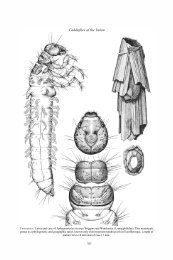Orthopteroids (Orthopteroidea) of the Yukon (V.R. Vickery)
Orthopteroids (Orthopteroidea) of the Yukon (V.R. Vickery)
Orthopteroids (Orthopteroidea) of the Yukon (V.R. Vickery)
Create successful ePaper yourself
Turn your PDF publications into a flip-book with our unique Google optimized e-Paper software.
232 V.R. <strong>Vickery</strong><br />
FIG. 6. Distribution <strong>of</strong> Arphia conspersa Scudder (8), a species that probably survived in a sou<strong>the</strong>rn refugium and<br />
subsequently increased its range.<br />
Biological information: Usually found in open areas and feeds on many grass species.The life cycle<br />
may require 3 or more years as it does in high elevations in Wyoming (Kreasky 1960). High-elevation<br />
and high-latitude responses are similar.<br />
Taxonomic notes: Prior to 1964 this species was thought to be Holarctic and was known as C. longicornis<br />
Latreille. The correct identity was established by <strong>Vickery</strong> (1964).<br />
13. Bruneria yukonensis <strong>Vickery</strong><br />
Small species, both sexes 18–25 mm; head small in proportion to body (Frontispiece); pronotum very<br />
little longer than head; tegmina reaching nearly to apex <strong>of</strong> abdomen; usually very dark, some<br />
specimens with yellowish median dorsal longitudinal line; tegmina shining, conspicuously<br />
spotted; hind femur with 3 oblique dark bands on outer face; hind tibia pale with apical third<br />
darker.<br />
Distribution: This species is endemic to <strong>the</strong> <strong>Yukon</strong>.<br />
<strong>Yukon</strong> records: Known from <strong>the</strong> type locality, shore <strong>of</strong> L. Laberge; Sheep Mt., Kluane National Park;<br />
Aishihik R.; and Sulphur L. (local regions 10 and 12, Fig. 1). Specimens: LEMQ, ROME, SMDV.<br />
The collection data for <strong>the</strong> male holotype are as follows: “<strong>Yukon</strong>, Lake Laberge shore, 62° N′; 135° W.,<br />
23-VIII-1961, D. Marsh”. A second label has additional data: “W. shore <strong>of</strong> lake; deep creek, no trees,<br />
grassy slope burned out by sun”. (Holotype in LEMQ, also Allotype and one female Paratype).<br />
Biological information: The life cycle is not known. Adults were collected from late July to late August.<br />
Taxonomic notes: Otte (1981) placed yukonensis in <strong>the</strong> Old World genus Stenobothrus but later (Otte<br />
1995) he reverted to Bruneria.<br />
14. Aeropedellus arcticus Hebard<br />
Small species, about 12–19 mm; male antennae strongly clavate, black, enlarged and thickened<br />
apically; males usually blackish green, females variable, head and pronotum <strong>of</strong>ten with conspicuous<br />
black, creamy white and green pattern.<br />
Distribution: Known only from <strong>the</strong> nor<strong>the</strong>rn parts <strong>of</strong> Alaska, <strong>Yukon</strong> and Northwest Territories. This<br />
is <strong>the</strong> only grasshopper species known to occur north <strong>of</strong> <strong>the</strong> Canadian mainland and it is <strong>the</strong> only
















